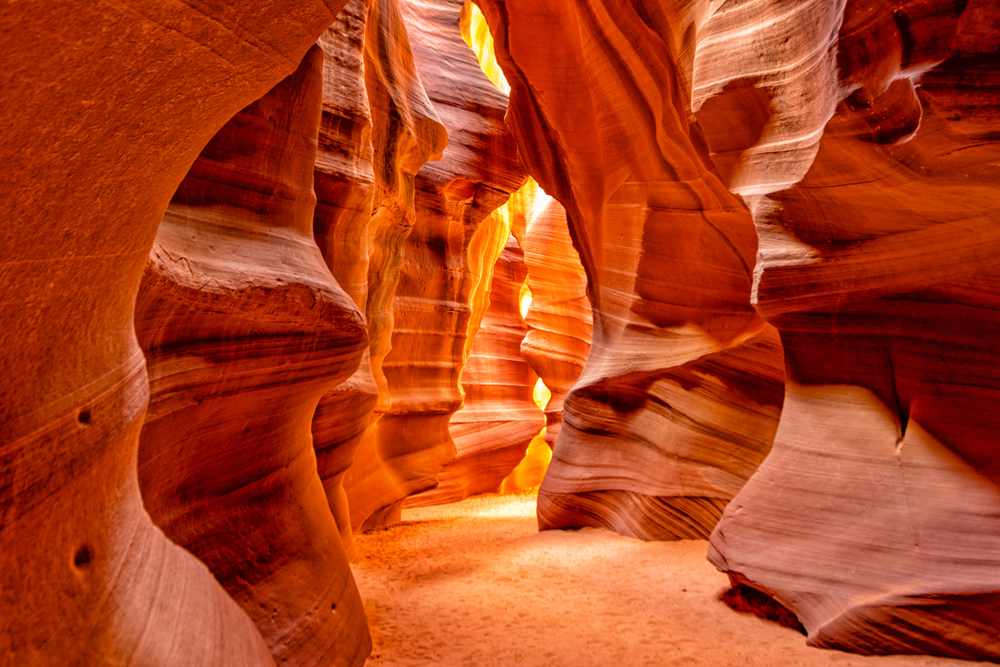
1. Devils Tower
Devils Tower is a colossal monument that appears to have sprouted directly from the underworld, towering above the trees of the Black Hills National Forest. Moreover, this incredible geological formation is the world’s largest example of columnar jointing. From the base to the top, Devils Tower is 264 meters high and is comprised of several three-meter-wide hexagonal columns.
Born from the flames of the Earth’s core, geologists believe that this monument has exploded through our planet’s crust like magma and cooled down near the surface. It’s this cooling process that gives rocks their special geometry. As the igneous rock cools down, it starts to contract around stress points, and over time the pressure builds up around these points.
As a consequence, cracks develop unique hexagonal shapes that release pressure, run from top to bottom, and form the structure’s multi-column architecture. While geologists have agreed on how columnar jointing forms, the unique grandeur of the Devils Tower still has them scratching their heads.

2. Antelope Canyon
The Antelope Canyon might not look so spectacular on the surface. Nevertheless, deep between the cavernous cracks of this sandstone landscape, there is a complex network of paths in stunning colors. Due to its sedimentary structure, sandstone is extremely susceptible to erosion and can be easily sculpted into structures and shapes. Antelope Canyon is no exception to this.
It is about 37 meters below the surface, and over millennia flash floods and strong winds carrying loose sediment have worn away at the sandstone to form what is known as the slot canyon.
Popular for being able to take tourists to the sandy subterranean world, Antelope Antelope Canyon is also flooded with a range of bright colors.
Sandstone naturally looks red because of its high iron content. At the Antelope Canyon, however, the shape of the slots causes the incoming light to bounce off the quartz-filled walls at various angles. This causes tonal changes in the colors that are reflected between the cracks of each canyon. Vibrant reds at the entrance of the crack can descend into a spectrum of oranges, yellows, pinks, and purples as the light reaches the canyon floor.

3. Wave Rock
Australia is well known as one of the world’s best spots for surfing the perfect wave. And there’s a wave 110 meters long near the town of Hyden. There is only one problem: it’s made of solid rock. Towering 15 meters into the air, this granite cliff, called Wave Rock, was formed over 2,500 million years ago. As one side of the inselberg (the isolated hill or mountain rising from the plain), this concave cliff is recognized as the ‘flared slope.’
Made by wind and rain erosion, it is composed of coarse-grained porphyritic granite and igneous rock with various minerals and crystals. As the wind and rain battered the wall, the softer rock at the base was undercut, creating a wave-like look. Rainfall not only helped shape the rock formation but also painted it with a series of red, brown, and yellow stripes.
While they can appear hand-painted, each vertical strip is an indicator of various mineral deposits washed down the slope, reacting with water, and creating different colors. Water-loving algae also play a part in the colorization of the cliff.

4. Rocky Forest
In the western US state of Utah, Bryce Canyon National Park is a red wonderland made of rocky forests. Towering spires of undulating rock seem to have arisen from the ground below, as far as the eye can see. Like many of the other awe-inspiring structures in this feature, these remarkable peaks are the result of millions of years of erosion. Once a vast plateau (a flat plain high above the ground), over time, the elements chipped away, gradually dissolving its landscape into these rocky sculptures, known as hoodoos.
This stone forest has come to exist due to the unusual rate of erosion of the plateau. Made up of various layers of rock, plateaus develop over millions of years, as sediment and rock pile up as a result of deposition or volcanic eruption. Each has different properties: some rocks, such as mudstone, react more quickly to erosion, while other layers of denser rock, such as limestone rock, dissolve more slowly. Such abnormality in the rate of erosion is known as ‘differential erosion’ and results in the development of hoodoo spires.

5. Chocolate Hills
Most mountains and hills are created by growing out of the ground for millions of years, but the Chocolate Hills formed after the world had melted away. Mountains usually form a solidified magma that has been pushed to the surface or as a result of two continents crashing into each other. In some cases, however, the mountains and other geological formations touch the sky in what are known as karsts.
Karsts are an area of land where rocky foundations, usually limestone, have been eroded by rainfall and groundwater. Created from ancient compacted marine organic matter (such as tiny fossilized crustaceans), calcium-rich limestone can easily be dissolved. Continued water erosion gradually produces caves and sinkholes, causing the surface of the limestone to collapse. On the other hand, the surface topography shifts, exposing mounds where patches of land haven’t sunk.
There are many examples of karsts all over the world, some with more spectacular and unusual hills hundreds of meters tall. What makes the Chocolate Hills so special is their repetition and smooth appearance. Approximately 1,260 to 1,776 of these almost dome-shaped hills spread throughout the area, from 30 to 120 meters in height.











































